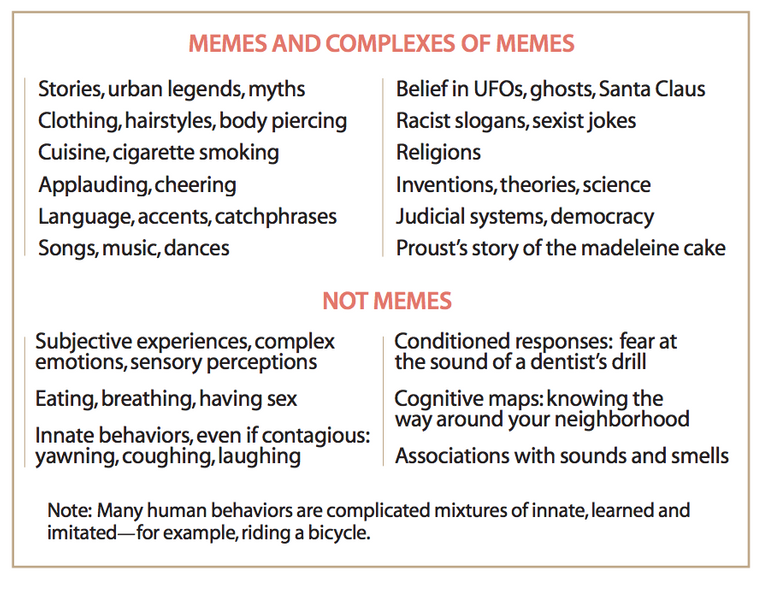
What is a Meme?
Did you know that you spend much of your life copying and transmitting entities called memes?
We are Ego-Centric and memes feed off of our Egos. We are biological machines and our selves, the Egos we identify with, are complex memes.
Meme's are symbols that carry the smallest amount of information that convey and propagate an idea. Meme's can be words, ideas, logos, poems, catch-phrases, images, movies, technological processes, and more. Memes are units of cultural transmission.

Culture can be defined as a pattern of behavior of a population embodied in thought, behavior, and artifacts. Memes and the ideas they cultivate are able to copy themselves through ourselves. Memes are not the same as ideas.
Memes are like genes and do not possess cognition or planning - they are algorithmic tools that society uses to drive natural selection. Bits of information that either succeed or fail in getting copied.Humans are products of genes and memes. British scholar Susan Blackmore theorizes that humans are just machines for propagating memes. The whole idea of a meme is that it's information copied with selection and variation. Any idea that is copied from person to person is a meme. But an idea that you think up for yourself and is not expressed is not a meme. Memes are using human brains as their copying machinery.
"The (news) media has huge, huge power to spread a meme because it's the major mechanism of copying."
The news and social media are catalysts in spreading memes and promoting meme culture. They create social validation feedback looks that exploit human psychology vulnerabilities. Smart phones are efficient and effective vehicles for propagating memes. From GIF's, BitMoji's, Emoji's, etc. Social media is not intrinsically bad, but finding a balance and the right media channels is important.
Meme Origin and Military Use

Memes are not new or novel, and did not origate on the internet. Shaking hands or singing Happy Birthday are basic examples of memes.
Richard Dawkins coined the term "meme" in The Selfish Gene. He defined it as a self-replicating and propagating information structure. Most memes are short, usually one to ten words. DARPA and other military projects have researched memes for decades. The military has also used relevant properties of memes to propagate, influence behavior, and persist throughout social media. Memes have been used by the military for recruitment, training, peacekeeping, and nation building.
Humans are not the only ones who are affected by memes. Memes affect the habits of many animals. "Memes may be older and more fundamental to biological evolution than anyone expects." From fish to foxes, animals copy one another in decision making and behaviors. Occuring in three stages: decision of what to imitate, transformation in body behavior, and eventually achieving a matched body behavior.
Powerful Information
Meme's are powerful because they can be transmitted, received, and understood by anyone. Regardless of race, religion, gender, or any other differentiating factor. Everyone identifies with them. Once a recipient receives the idea or message through the meme, they simultaneously their experiences and sources of background information to it.

Memes are copy machines and highly adept at diffusing tension. No one likes to be uncomfortable. Memes are an instrument to defer that uncomfortable tension into a meme like a grumpy cat or a clip from a funny movie. Politics and religion are prime examples of how memes have diffused the tension surrounding those once 'taboo' conversation topics. The line between satire and reality become skewed.
The information of a meme can be either long or short. It can be calculated from letters or symbols. Entropy can be defined as quantity of information. The entropy of a meme can be short or long. The entropy per letter of an 8-letter chunk of English is 2.3 bits per letter, using a 26-character set. The more entropy exhibited, the larger the size of the meme must be conveyed through the message.

Small Memes = less than or equal to 100,000 bits
Medium Memes = less than or equal to 100,000,000 bits
Large Memes = greater than 100,000,000 bits
 Source
Source
Entropy metrics are rough estimates and not correlated to the memes ability to propagate, persist, and alter behavior. Once memes have been let loose in society, they are out there forever.
Memes and Culture
Culture is the set of values shared by a group of people. All culture is relative, learned, and based on common experiences and heritage. Once learned, culture sets the stage for behavior standards in return for acceptance. Culture drives behavior. Culture gives us a meaningful narrative to answer the questions like what's my past, present, and future going to look like? Everyone creates their own narratives - personal stories about who they are, what the world is like, and how they interact with it.
Here's the interesting part.. narratives are directly influenced by symbols, symbolic actions, stories, metaphors, and more - which by definition - are memes.Through technology, the flow of information is increasing at exponentially fast rates. It's a battle of information for attention. We are able to communicate and share ideas in milliseconds across multiple mediums in real-time. As a result, cultural changes occur more quickly.
And unfortunately, as more information is shared at increasing rates, the truth is oftentimes lost in the message. In today's information overloaded world, it's hard to discern what you read, see, and hear to be true. At what point does it all become Fake News or a truth that's been skewed too many times via memes? We live in an attention economy, and its our scarcest resrouce. Memes are the ultimate tools for politicians, social media, government, and anyone looking to copy information from one agent to the next.
Conclusion
Much like DNA, meme culture is always evolving. Memes used to be for the internet-savvy individuals to convey their ideas about internet and pop culture. But have now infiltrated everyday social networking platforms, that 81 percent of the population in the United States use, like Snapchat, Facebook, and Twitter. Be wary of the memes you empathize with and send out into the world.
